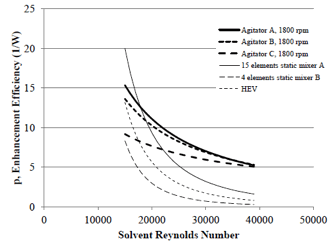Reports: ND956889-ND9: Novel Turbulence Stimulation Techniques for Heat Transfer Enhancement
Jacques Zakin, PhD, Ohio State University
Research on developing new techniques for enhancing the poor heat transfer to or from drag reducing surfactant solutions focused on two novel new approaches.
The first involved design and construction of internal rotating impellers fitted into the inner tube of the exchanger through which the drag reducing surfactant solution flowed. Three impellers were designed, constructed, and tested. The most effective was Agitator B, shown in Figure 1, which increased the heat transfer rate to exceed that of water by up to 20 per cent below a solvent Reynolds number of 15,000.
Figure 1: 3D model and cross-section of Agitator B
The enhancement was accomplished with only modest power input and no degradation of the drag reducing behavior of the surfactant solution. An enhancement efficiency parameter was defined as the decrease in heat transfer reduction divided by energy input or dissipation. The impeller shown in Figure 2 was the most efficient.
Figure 2: 3D model and cross-section of Agitator A
The rotating agitators were more than twice as energy efficient as previously studied enhancement techniques at Reynolds numbers greater than 35,000 (Figure 3).
Figure 3: Enhancement efficiency
These results are included in Dr Andrew Maxson’s PhD Dissertation (Heat Transfer Enhancement in Turbulent Drag Reducing Solutions). Maxson received his PhD degree in August 2017.
The second major research thrust has been in utilizing the unique behavior of a drag reducing zwitterionic/cationic surfactant mixture discovered in our lab to enhance heat transfer. Surprisingly, certain drag reducing formulations precipitate from solution on dilution. This system also completely loses its drag reducing ability over a very short (less than 1 C) temperature range while most other drag reducing solutions lose this ability gradually over a much wider temperature range. Its solubility is also very sensitive to shear.
Four undergraduates, PhD candidate Ross Chongson and Dr. Andrew Maxson are involved in exploring novel techniques to utilize these unusual behaviors to enhance heat transfer in shell and tube exchangers while regaining drag reducing behavior downstream of the exchanger.
Two other approaches to enhancing heat transfer have a lower priority as they are less promising. Exploratory experiments in recycling magnetic particles through the heat exchanger while forcing them to circulate in the exchanger utilizing fluctuating magnetic fields were modestly successful but the retention of the magnetic particles was only about 65%, so this approach may not be practical.
The use of pulsating flows to enhance heat transfer were also explored. While some modest improvements in heat transfer were observed, the improvements do not seem promising so this approach has been abandoned.














